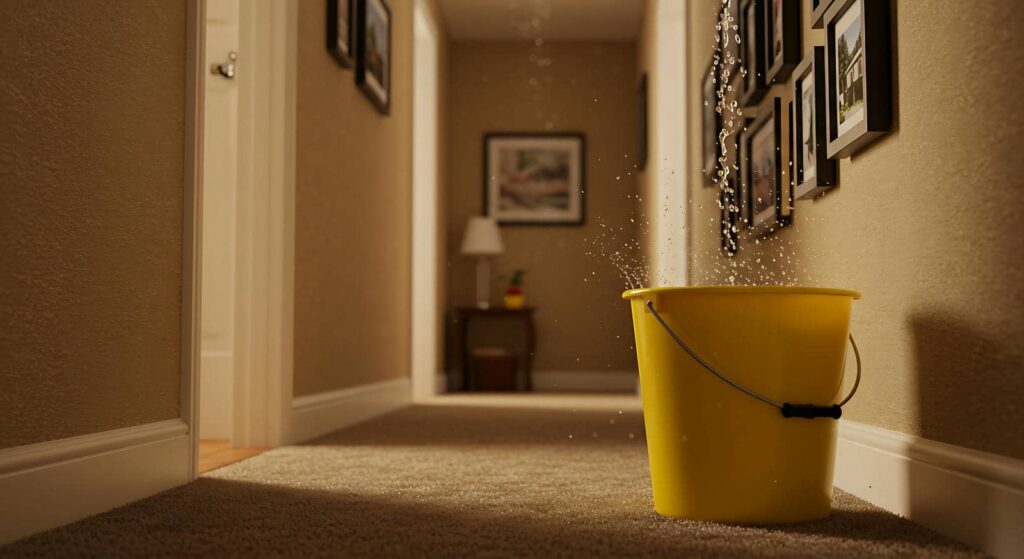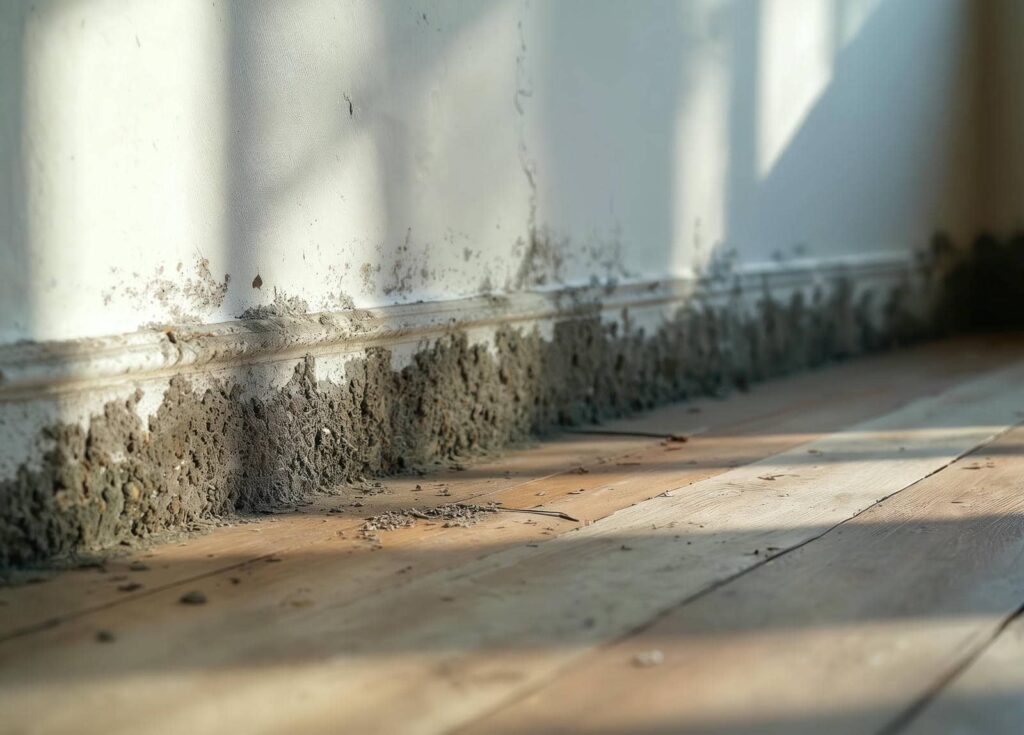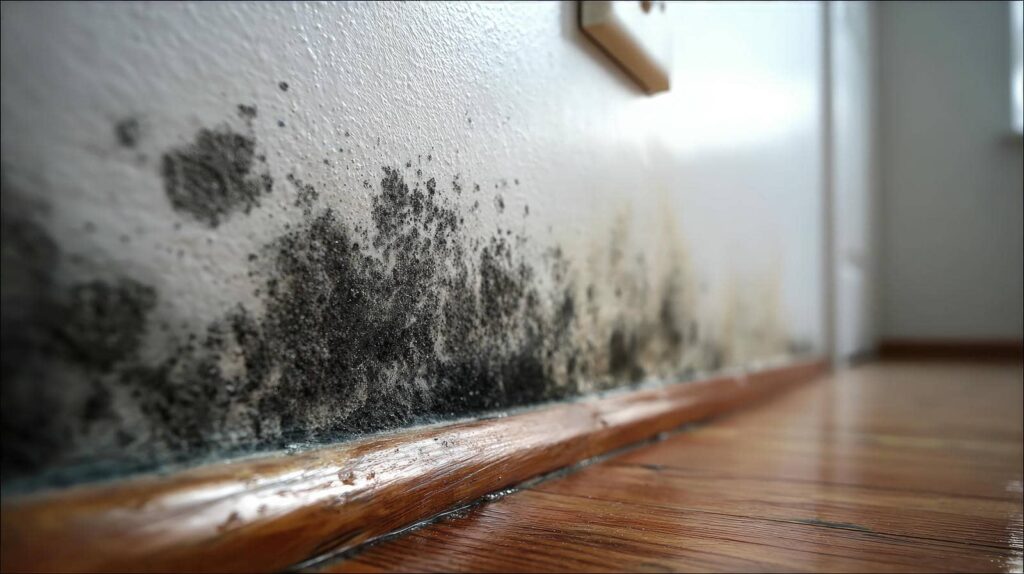Contents
You may think water damage is just a minor inconvenience, but when it comes to your home’s foundation, the impact can be monumental. Imagine your foundation slowly losing its strength, silently succumbing to the effects of water infiltration. As the foundation weakens, cracks begin to form, signaling the start of a potentially costly and dangerous situation. Stay tuned to discover how this seemingly small issue can have significant repercussions for your home’s stability and your family’s safety.
Key Takeaways
- Water damage weakens foundation materials, leading to structural instability.
- Soil erosion from water exposure compromises foundation integrity.
- Moisture absorption causes soil shifting and foundation cracks.
- Proper drainage systems prevent soil saturation and foundation damage.
- Timely repairs and waterproofing protect against long-term structural weaknesses.
Soil Erosion
Soil erosion occurs when water damage weakens the foundation, leading to the gradual loss of soil particles, impacting the stability of your home. To combat this issue, implementing effective landscaping solutions can be crucial.
Properly designed drainage systems can help redirect water flow away from your home’s foundation, preventing erosion. Ensuring that water is properly channeled away from vulnerable areas is essential in maintaining the integrity of your property.
In addition to implementing drainage systems, soil compaction plays a significant role in preventing erosion. Compacted soil is more resistant to water damage and less likely to erode. By regularly compacting the soil around your home, you can reduce the risk of erosion and protect your foundation.
Vegetation control is another key aspect to consider when preventing soil erosion. Plants with deep root systems can help anchor the soil in place, reducing the likelihood of erosion. Properly maintaining vegetation around your home can enhance soil stability and decrease the impact of water damage on your foundation.
Structural Weakness
Your home’s foundation faces risks of instability due to water damage. Excessive moisture absorption can weaken the structural integrity of the foundation, leading to potential cracks and sinking.
Understanding these dangers is crucial in preventing long-term structural weakness in your home.
Foundation Instability Risks
Foundation instability risks can result from prolonged exposure to water damage, leading to potential structural weaknesses compromising building stability. To address these risks effectively, consider implementing the following measures:
Effective Drainage Solutions: Properly designed and maintained drainage systems help redirect water away from the foundation, reducing the risk of water infiltration.
Strategic Landscaping Techniques: Sloping the soil away from the foundation and ensuring proper grading around the house can prevent water from pooling near the structure.
Quality Waterproofing Methods: Applying waterproof coatings or sealants to the foundation walls can help prevent water from seeping into the building’s structure.
Timely Foundation Repair: Regular inspections and prompt repairs of any foundation cracks or damage can prevent further deterioration and strengthen the overall stability of the home.
Moisture Absorption Dangers
How does moisture absorption pose significant dangers to the structural integrity of your home? When moisture seeps into your home’s foundation, it can lead to various structural weaknesses that compromise the stability of the entire building. Here are some critical points to consider:
| Moisture Absorption Dangers | Impact | Prevention |
|---|---|---|
| Increased soil moisture content | Weakens foundation materials | Implement proper drainage systems |
| Expansion and contraction of soil | Causes shifting and settling | Ensure effective landscaping to direct water away from the foundation |
| Corrosion of metal reinforcements | Reduces structural strength | Apply waterproofing solutions to protect against water intrusion |
To mitigate these dangers, consider investing in waterproofing solutions such as sealants and membranes to keep water out. Additionally, landscaping improvements and drainage systems can help redirect water away from the foundation, reducing the risk of moisture absorption. By implementing these prevention methods, you can safeguard your home’s foundation from the detrimental effects of moisture infiltration.
Cracks and Sinking
Excessive soil moisture levels can contribute to the development of cracks and sinking in a home’s structural foundation. When water accumulates around the foundation, it exerts pressure on the walls, leading to cracks and weakening the overall structure.
Here are some key points to consider in addressing this issue:
Effective Drainage Systems: Installing proper drainage systems such as French drains can help redirect water away from the foundation, preventing soil saturation and potential damage.
Waterproofing Techniques: Applying waterproof coatings and sealants to the foundation walls can help prevent water infiltration, reducing the risk of cracks and sinking.
Landscaping Solutions: Proper landscaping can also play a crucial role in preventing water damage to the foundation. Ensuring proper grading and sloping away from the house can help direct water flow away from the structure.
Preventive Measures: Regularly inspecting the foundation for any signs of damage and addressing them promptly can help prevent further deterioration and costly repairs down the line.
Cracks in Walls
When cracks appear in your walls due to water damage, it signifies potential issues with the structural integrity of your home.
These cracks can allow moisture to seep into the walls, leading to further damage and compromising the stability of your home’s foundation.
Addressing these cracks promptly is crucial to preventing escalating problems that could impact your home’s safety and longevity.
Wall Structural Integrity
Inspecting the walls for cracks is crucial in assessing the structural integrity of your home foundation in the context of water damage. Here are some key points to consider:
Crack Size and Location: Small hairline cracks are common and may not be a cause for concern. However, larger cracks, especially those near corners or windows, could indicate more serious issues with the foundation.
Vertical vs. Horizontal Cracks: Vertical cracks are often a result of settlement and may not be as severe as horizontal cracks, which could suggest pressure from the soil outside the foundation.
Foundation Movement: Monitoring cracks for any signs of movement, such as widening or shifting, can help determine the extent of the damage and the urgency of repairs.
Professional Inspection: Consulting with a foundation repair specialist is advisable for a thorough assessment and recommendations on waterproofing methods, drainage solutions, preventive maintenance, and appropriate repairs to ensure the structural integrity of your home.
Moisture Absorption Effects
Consider the potential structural implications of this phenomenon to assess the impact of moisture absorption on cracks in walls. When walls absorb moisture, especially in areas prone to water damage, such as basements, they can develop cracks. These cracks not only compromise the integrity of the walls but also create an entry point for further water infiltration, exacerbating the issue.
Moisture absorbed by walls can create an ideal environment for mold growth. Implementing effective drainage solutions is crucial to prevent mold formation and address the root cause of the issue. Proper drainage helps redirect water away from the foundation, reducing the risk of moisture absorption and subsequent wall damage.
In addition to drainage solutions, waterproofing methods protect walls from moisture absorption. Applying waterproof coatings or membranes can create a barrier that prevents water from seeping into the walls.
If cracks have already formed due to moisture absorption, timely foundation repair is necessary to restore the structural integrity of the walls and prevent further damage.
Foundation Stability Compromise
Moisture absorption leading to cracks in walls can significantly compromise the stability of a home’s foundation. When water seeps into the walls due to poor drainage systems or improper landscaping solutions, it can have detrimental effects on the structural integrity of the foundation.
Here are key points to consider:
Drainage Systems: Effective drainage systems are crucial in preventing water accumulation around the foundation. Poor drainage can lead to excess moisture, increasing the likelihood of cracks forming in the walls.
Landscaping Solutions: Proper landscaping solutions, such as grading the soil away from the foundation and installing adequate vegetation, can help mitigate water damage. Well-planned landscaping can prevent water from pooling near the walls and causing structural issues.
Foundation Inspection: Regular inspections of the foundation for any signs of cracks or water damage are essential. Addressing these issues promptly can prevent further deterioration and maintain the stability of the home.
Professional Repairs: If cracks in the walls are detected, seeking professional help for repairs is crucial. Ignoring these cracks can lead to more severe foundation problems over time.
Foundation Settlement
Foundation settlement occurs when the soil beneath your home compresses or shifts, leading to uneven stress on the foundation. This can result from various factors such as poor soil compaction, excessive moisture levels, or even natural ground movement.
Identifying warning signs of foundation settlement is crucial. Keep an eye out for cracks in the walls, especially near doors and windows, sloping floors, or gaps between the walls and ceiling. Addressing these signs promptly can prevent further damage.
To mitigate foundation settlement, consider implementing prevention methods like proper grading around the house to ensure water drains away from the foundation. Installing a good drainage system can also help in managing water flow.
If foundation settlement has already occurred, repair solutions such as foundation underpinning or hydraulic jacking can be effective. These methods aim to stabilize and level the foundation, preventing further structural issues.
The long-term effects of foundation settlement can be severe if left unattended. It can lead to extensive structural damage, compromising the safety and stability of your home. Therefore, it’s essential to monitor warning signs diligently and take proactive measures to address foundation settlement promptly.
Mold Growth
Inspecting your home regularly for signs of mold growth is crucial in maintaining a healthy indoor environment. Mold can thrive in damp environments, posing health hazards to you and your family.
Understanding the importance of mold prevention and moisture control is key to safeguarding your home against mold growth. Here are some essential points to consider:
Mold Prevention: Taking proactive steps to prevent mold growth is vital. Ensure proper ventilation in areas prone to moisture buildup, such as bathrooms and basements. Repair any leaks promptly to prevent water intrusion that can lead to mold growth.
Moisture Control: Keep indoor humidity levels below 60% to inhibit mold growth. Consider using dehumidifiers in humid areas of your home. Properly insulate pipes to prevent condensation and reduce the risk of mold formation.
Health Hazards: Mold exposure can trigger allergic reactions, respiratory issues, and other health problems. It’s crucial to address mold growth promptly to prevent these health hazards from affecting your well-being.
Mold Exposure: Prolonged exposure to mold can exacerbate existing health conditions and lead to the development of new ones. Be vigilant in identifying and eliminating mold growth to maintain a healthy living environment for you and your loved ones.
Weakening of Support Beams
Addressing the weakening of support beams in your home requires a thorough assessment of structural integrity and timely intervention to prevent further damage. Support beams are crucial components of your home’s foundation, providing essential structural support. When exposed to water damage, these beams can weaken, compromising the stability of your entire house. To prevent this, beam reinforcement is essential.
Water damage can lead to the deterioration of support beams, especially in areas prone to flooding or leaks. The excess moisture weakens the wood, making it susceptible to rot and decay. Regular inspections of these beams can help identify early signs of damage. If weakening is detected, immediate action is necessary to prevent further structural issues.
To reinforce weakened support beams, various methods can be employed. This includes adding additional support columns, installing steel braces, or using epoxy injections to strengthen the wood. These interventions help restore the beams’ structural integrity and prevent collapse.
In the realm of water damage prevention, maintaining proper drainage around your home, fixing leaks promptly, and ensuring good ventilation in crawl spaces are crucial steps. By addressing these issues proactively, you can safeguard your support beams from weakening due to water damage, ultimately preserving the foundation of your home.
Damp Basement
To mitigate the risks associated with water damage impacting your home’s foundation, it’s crucial to address the issue of a damp basement promptly. A damp basement not only affects the structural integrity of your home but also creates an environment conducive to mold growth and potential flooding. Here are some key points to consider:
Waterproofing Solutions: Implementing effective waterproofing solutions such as sealants and coatings can help prevent water from seeping into your basement walls and floor, reducing the risk of dampness.
Drainage Systems: Installing proper drainage systems like sump pumps and French drains can efficiently redirect excess water away from your home’s foundation, preventing basement flooding and keeping the area dry.
Basement Flooding: Regularly inspecting your basement for signs of water intrusion, such as pooling water or damp spots, can help you detect potential flooding issues early on and take necessary actions to prevent extensive damage.
Mold Prevention: Maintaining proper ventilation, controlling humidity levels, and promptly addressing any water leaks or dampness in your basement are essential steps in preventing mold growth, which can be harmful to both your home’s structure and your health.
Pest Infestation
Effective pest control measures are essential in safeguarding your home’s foundation from potential damage caused by pest infestation. Pest infestations, such as termites or carpenter ants, can compromise the structural integrity of your home by feeding on wood components, including the foundation.
Implementing prevention methods is crucial to prevent such issues. Start by ensuring proper ventilation in crawl spaces and attics, as excessive moisture can attract pests. Additionally, sealing cracks and crevices in your home’s exterior can help keep pests out.
If you suspect a pest infestation, prompt action is necessary to avoid further damage. Treatment options vary depending on the type of pest present. For example, termites may require specialized termite baits or liquid treatments, while carpenter ants may need targeted insecticide applications. However, these treatments often provide only short-term relief.
For long-term solutions and to ensure the protection of your home’s foundation, seeking professional help is advisable. Pest control experts can conduct thorough inspections to identify the extent of the infestation and recommend appropriate measures. They may also provide ongoing maintenance to prevent future infestations, ultimately safeguarding your home against potential foundation damage.
Decreased Property Value
Implementing proper maintenance practices is crucial in mitigating factors that could lead to decreased property value. When water damage affects your home, it can have significant financial implications that go beyond just repair costs. Here’s why water damage can impact your property value:
Financial Implications: Water damage can result in a decrease in the overall value of your property. Potential buyers may be hesitant to invest in a home with a history of water damage, leading to a reduced selling price.
Property Maintenance: Lack of proper maintenance to address water damage issues can further devalue your property. Regular inspections and timely repairs are essential to maintain your home’s value.
Insurance Coverage: Depending on your insurance policy, coverage for water damage may be limited. Insufficient coverage can result in out-of-pocket expenses for repairs, further impacting your property’s value.
Repair Costs: The costs associated with repairing water damage can be substantial. From fixing structural issues to addressing mold growth, these expenses can add up quickly and reduce the overall value of your home.
Understanding the implications of water damage on your property value is essential for maintaining the long-term investment in your home. By prioritizing proper maintenance and addressing water damage promptly, you can help preserve and potentially increase the value of your property.
Recap
In conclusion, the detrimental effects of water damage on home foundations can’t be overstated. The impact is pervasive and severe, from soil erosion to mold growth and cracks in walls to the weakening of support beams.
Ignoring these issues is like inviting a tornado into your living room – it’s a disaster waiting to happen. Addressing water damage promptly and effectively is crucial to maintaining the structural integrity and safety of your home.




